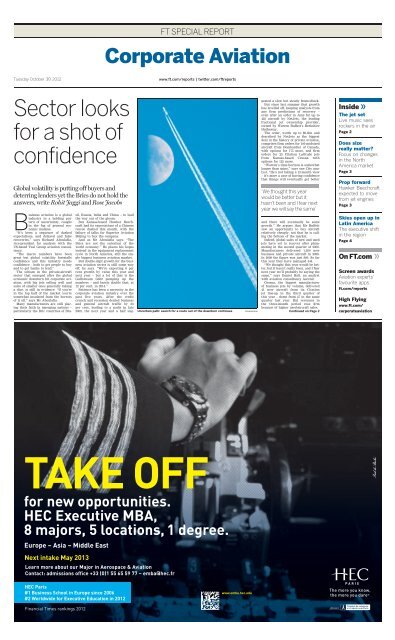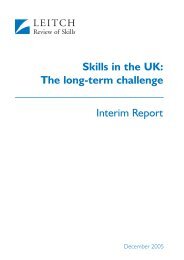Corporate Aviation - Financial Times - FT.com
Corporate Aviation - Financial Times - FT.com
Corporate Aviation - Financial Times - FT.com
You also want an ePaper? Increase the reach of your titles
YUMPU automatically turns print PDFs into web optimized ePapers that Google loves.
<strong>FT</strong>SPECIALREPORT<br />
<strong>Corporate</strong><strong>Aviation</strong><br />
TuesdayOctober 30 2012 www.ft.<strong>com</strong>/reports | twitter.<strong>com</strong>/ftreports<br />
Sectorlooks<br />
forashotof<br />
confidence<br />
Globalvolatilityisputtingoffbuyersand<br />
deterringlendersyettheBricsdonotholdthe<br />
answers,writeRohitJaggiandRoseJacobs<br />
Business aviation is a global<br />
industry in a holding pattern<br />
of uncertainty, caught<br />
in the fog of general economic<br />
malaise.<br />
“It’s been a sequence of dashed<br />
expectations, and delayed and false<br />
recoveries,” says Richard Aboulafia,<br />
vice-president for analysis with the<br />
US-based Teal Group aviation consultancy.<br />
“The macro numbers have been<br />
great but global volatility forestalls<br />
confidence and this industry needs<br />
confidence – both to get people to buy<br />
and to get banks to lend.”<br />
The schism in the private-aircraft<br />
sector that emerged after the global<br />
economic downturn hit corporate aviation,<br />
with big jets selling well and<br />
sales of smaller ones generally taking<br />
a dive, is still in evidence. “If you’re<br />
in the top half of the market you’re<br />
somewhat insulated from the horrors<br />
of it all,” says Mr Aboulafia.<br />
Many manufacturers are still placing<br />
their faith in emerging nations –<br />
particularly the Bric countries of Bra-<br />
zil, Russia, India and China – to lead<br />
the way out of the gloom.<br />
But Kansas-based Hawker Beechcraft<br />
had its expectations of a Chinese<br />
rescue dashed this month, with the<br />
failure of talks for Superior <strong>Aviation</strong><br />
Beijing to buy the <strong>com</strong>pany.<br />
And as Mr Aboulafia says: “The<br />
Brics are not the salvation of the<br />
world economy.” He places his hopes<br />
instead in the equipment replacement<br />
cycle in North America, still the single<br />
biggest business aviation market.<br />
But double-digit growth for the business<br />
aviation sector is still some way<br />
off, he says. “We’re expecting 6 per<br />
cent growth by value this year and<br />
next year – but a lot of that is the<br />
Gulfstream G650 pumping up the<br />
numbers – and barely double that, at<br />
12 per cent, in 2014.”<br />
Patience has been a necessity in the<br />
corporate aviation industry over the<br />
past five years. After the credit<br />
crunch and recession dented business<br />
and general aircraft traffic by 30<br />
per cent, leading to a nadir in late<br />
2009, the next year and a half sug-<br />
Uncertainpath:searchforarouteoutofthedownturncontinues Dreamstime<br />
gested a slow but steady bounceback.<br />
But since last summer that growth<br />
has levelled off, keeping analysts from<br />
any firm predictions of recovery –<br />
even after an order in June for up to<br />
425 aircraft by NetJets, the leading<br />
fractional jet ownership provider,<br />
owned by Warren Buffett’s Berkshire<br />
Hathaway.<br />
The order, worth up to $9.6bn and<br />
described by NetJets as the biggest<br />
deal in the history of private aviation,<br />
<strong>com</strong>prises firm orders for 100 midsized<br />
aircraft from Bombardier of Canada,<br />
with options for 175 more, and firm<br />
orders for 25 Citation Latitude jets<br />
from Kansas-based Cessna with<br />
options for 125 more.<br />
“Warren’s time horizon is somewhat<br />
longer than mine,” says one City analyst.<br />
“He’s not taking a 12-month view<br />
– it’s more a case of having confidence<br />
that things will eventually get better<br />
‘Wethoughtthisyear<br />
wouldbebetterbutit<br />
hasn’tbeenandIfearnext<br />
yearwewillsaythesame’<br />
and there will eventually be some<br />
growth.” He argues that Mr Buffett<br />
saw an opportunity to buy aircraft<br />
relatively cheaply, not that he is calling<br />
the bottom of the market.<br />
Indeed, global sales of new and used<br />
jets have yet to recover after plummeting<br />
in the second quarter of 2008.<br />
Manufacturers delivered 1,200 new<br />
business and private aircraft in 2008.<br />
In 2009 the figure was just 800. So far<br />
this year they have managed 444.<br />
“We thought this year would be better,butithasn’treallybeen,<br />
and I fear<br />
next year we’ll probably be saying the<br />
same,” says Daniel Hall, an analyst<br />
with aviation consultancy Ascend.<br />
Cessna, the biggest manufacturer<br />
of business jets by volume, delivered<br />
41 new aircraft from its Citation<br />
jet line-up in the third quarter of<br />
this year – down from 47 in the same<br />
quarter last year. But revenues in<br />
the three-month period rose $7m<br />
because of higher used-aircraft sales.<br />
ContinuedonPage2<br />
Inside»<br />
The jet set<br />
Live music sees<br />
rockers in the air<br />
Page 2<br />
Does size<br />
really matter?<br />
Focus on changes<br />
in the North<br />
America market<br />
Page 3<br />
Prop forward<br />
Hawker Beechcraft<br />
expected to move<br />
from jet engines<br />
Page 3<br />
Skies open up in<br />
Latin America<br />
The executive shift<br />
in the region<br />
Page 4<br />
On<strong>FT</strong>.<strong>com</strong>»<br />
Screen awards<br />
<strong>Aviation</strong> experts’<br />
favourite apps<br />
ft.<strong>com</strong>/reports<br />
High Flying<br />
www.ft.<strong>com</strong>/<br />
corporateaviation
2 ★ FINANCIALTIMESTUESDAYOCTOBER302012<br />
Mixedfortunes<br />
forjet buyers<br />
Finance<br />
Thereisadivergence<br />
betweenloansforbig<br />
andsmallaircraft,<br />
saysRoseJacobs<br />
Optimism is growing in the<br />
private jet world that the<br />
financiers who disappeared<br />
after the credit crunch and<br />
began resurfacing in earnest<br />
only last year may<br />
soon be abundant enough<br />
to drive prices down.<br />
“I’m getting calls from<br />
banks now as opposed to<br />
having to call them,” says<br />
Aoife O’Sullivan, a lawyer<br />
with aviation solicitors<br />
Gates and Partners.<br />
“They’re even <strong>com</strong>peting on<br />
basis points. We just did a<br />
deal for 2 points above<br />
Libor [the interbank lending<br />
rate].”<br />
That, she says, would<br />
have been unheard of even<br />
five or six months ago.<br />
But fortunes are mixed,<br />
with buyers in the US finding<br />
it easier than their overseas<br />
counterparts to access<br />
reasonably priced loans,<br />
and with money for bigger,<br />
longer-range aircraft easier<br />
to <strong>com</strong>e by than financing<br />
for light and very light jets.<br />
Regional differences are<br />
diminishing, thanks both to<br />
local liquidity increasing<br />
and to western banks<br />
adjusting their views of<br />
repossession risk. Tracy<br />
Cassil, senior vice-president<br />
of global finance at Cessna’s<br />
financing arm,<br />
observes that in Latin<br />
America – and particularly<br />
Brazil – local lenders are<br />
offering more affordable<br />
deals: “I see incredible<br />
availability there,” he says.<br />
But the diverging experiences<br />
of small-aircraft and<br />
larger-aircraft buyers<br />
remain. This <strong>com</strong>es down to<br />
two factors. First, the valuations<br />
of smaller aircraft<br />
took a worse tumble postcredit<br />
crunch than those of<br />
the bigger models, leaving<br />
some lenders particularly<br />
fearful of that market. Second,<br />
the sheer scale of a<br />
deal can have an impact,<br />
with middle men aware<br />
they will make more money<br />
on bigger transactions.<br />
“It’s a capacity issue,”<br />
says Jay Heublein, vicepresident<br />
at Nextant Aersopace,<br />
which refits light<br />
jets with new engines and<br />
more aerodynamic fittings.<br />
“There’s a limited<br />
number of dollars out there<br />
right now and if you’re a<br />
banker, and you have the<br />
opportunity of doing one<br />
$50m deal or 10 $5m deals,<br />
where are you going to<br />
migrate?”<br />
For the bigger deals, Ms<br />
O’Sullivan is seeing interest<br />
from alternative investors,<br />
including private equity<br />
groups and even one US<br />
pension fund.<br />
“You’re looking at<br />
returns of 8 to 9 per cent for<br />
an average term of five to<br />
seven years,” she says,<br />
underscoring the appeal of<br />
corporate aircraft to both<br />
types of investor – provided<br />
the industry can reassure<br />
lenders on risk.<br />
Leasing <strong>com</strong>panies are<br />
meanwhile stepping up<br />
their presence at corporate<br />
jet conferences, suggesting<br />
an interest in expanding<br />
their activities in the sector,<br />
from mostly finance<br />
leases to include the area of<br />
operating leases.<br />
Still, cash remains traditional<br />
lenders’ biggest <strong>com</strong>petition,<br />
with 60 per cent of<br />
private aircraft purchases<br />
paid for upfront by rich<br />
individuals or <strong>com</strong>panies<br />
with strong balance sheets,<br />
according to Paul Sheridan<br />
at the consultancy Ascend.<br />
Mr Heublein questions<br />
how necessary alternatives<br />
will be, as traditional lenders<br />
warm to private jets<br />
once again. “The money’s<br />
going to flow to the bigger<br />
deals first, and when the<br />
market starts to get better,<br />
it will trickle down.”<br />
<strong>Corporate</strong><strong>Aviation</strong><br />
Rockin’andflyingallovertheworld<br />
CharterMusicstarsreachfortheskiesasdemandforliveperformancesincreases,writesDuncanRobinson<br />
Rock stars and private aviation<br />
do not always mix well.<br />
Buddy Holly died after his<br />
chartered plane crashed in<br />
Iowa in 1959, with Jiles P<br />
Richardson – known as the Big Bopper<br />
– and Ritchie Valens. Lynyrd Skynyrd<br />
lost a lead singer, guitarist and<br />
backing vocalist when their chartered<br />
flight ploughed into a swamp in 1977.<br />
You could forgive superstitious rockers<br />
for avoiding private air travel.<br />
Now, however, rock stars are flocking<br />
to the skies as demand for live<br />
music rockets. With CD sales down by<br />
half since 2004, bands needed to find<br />
new sources of revenues – and fast.<br />
Touring has plugged this gap. “We<br />
have definitely seen an increase in<br />
touring,” says Alex Berry, sales and<br />
marketing director at Chapman Freeborn,<br />
the aircraft charter <strong>com</strong>pany.<br />
Pragmatism, not luxury, drives the<br />
demand, however. “The reality is, a<br />
big touring band couldn’t make their<br />
tour schedule without having <strong>com</strong>plete<br />
control of the aircraft,” he says.<br />
Bands on tour now perform more<br />
dates, and itineraries have be<strong>com</strong>e sp<br />
crowded that chartered aircraft are<br />
one of the few ways to <strong>com</strong>plete them.<br />
Chapman Freeborn has been flying<br />
band tours since the 1970s. “One of<br />
our first big clients was the Rolling<br />
Stones,” says Mr Berry. Today, the<br />
<strong>com</strong>pany does more than 40 tours a<br />
year, taking care of the travel<br />
arrangements for bands such as Coldplay<br />
and the Eagles.<br />
Other industry players are muscling<br />
in on the trend. Air Partner, the publicly<br />
traded private aircraft group in<br />
the UK, has explicitly chased business<br />
in the sector, working with acts such<br />
as Carlos Santana, the guitarist.<br />
“It’s true we’ve seen an increase in<br />
the business that we’re doing in the<br />
segment,” says Phil Mathews, president<br />
at the group. “That’s down to a<br />
more aggressive sales approach –<br />
we’re targeting the sector.”<br />
The cost of a chartered flight – <strong>com</strong>pared<br />
with a tour bus – is reasonable<br />
when put against the convenience,<br />
says Patrick Margetson-Rushmore,<br />
chief executive of London Executive<br />
<strong>Aviation</strong>, an operator that does about<br />
a dozen tours a year.<br />
A day return on a medium-sized aircraft,<br />
such as an Embraer Legacy 600,<br />
will cost approximately £20,000, and<br />
Groupbooking:<br />
KeithRichards<br />
andfellowStones<br />
RonnieWoodand<br />
CharlieWatts<br />
Reuters<br />
will fly about a dozen people.<br />
“You can leave your tour date – you<br />
don’t have to stay in the hotel – and<br />
fly to your next destination,” says Mr<br />
Margetson-Rushmore.<br />
“You’ve saved a day. It’s an<br />
extremely cost-effective method of<br />
moving people around.”<br />
However, while the figures add up<br />
for a band filling stadiums across<br />
Privatetrend Risingdemandforairambulanceandsearchandrescueservices<br />
The UK’s plans to privatise<br />
its entire helicopter search<br />
and rescue (SAR) service this<br />
spring have focused attention<br />
on the industry’s growing<br />
value to the private sector,<br />
writes Rose Jacobs. But<br />
another area where aviation<br />
and medical services overlap<br />
is also quietly proving itself a<br />
growth market: the provision<br />
of air ambulance services<br />
and aircraft.<br />
The same drivers of<br />
growth for SAR – from rising<br />
prosperity in developing<br />
countries to austeritydriven<br />
privatisation in developed<br />
ones – are pushing air<br />
ambulances forward. But the<br />
smaller market also benefits<br />
from unique trends, including<br />
the move by insurance<br />
<strong>com</strong>panies to add air<br />
ambulance to their list of<br />
services, and the demand of<br />
businessmen and women to<br />
be promised air ambulance<br />
access when abroad.<br />
Ascend, the aviation<br />
Industrylooksforashotofconfidence<br />
ContinuedfromPage1<br />
Brad Thress, senior vicepresident<br />
for Cessna’s business<br />
jets division, says he is<br />
seeing “a great deal of interest<br />
in the Citation Latitude,<br />
particularly from customers<br />
who already own or operate<br />
a midsize Cessna Citation<br />
and are planning their<br />
future purchases, and we<br />
expect further orders in<br />
2013. The major order from<br />
NetJets for up to 150 Latitudes<br />
is a significant<br />
endorsement.”<br />
Some fear, however, that<br />
the NetJets purchase may<br />
actually harm some parts of<br />
the industry. Most manufacturers<br />
take buyers’ old jets<br />
in as part-exchanges.<br />
When NetJets bought<br />
replacements for their Gulfstream<br />
IV and IV SPs about<br />
a year ago, the old aircraft<br />
flooded the second-hand<br />
market, causing values to<br />
crash. That could well happen<br />
again if the new order<br />
prompts the <strong>com</strong>pany to<br />
cast off midsize models<br />
such as Citation X or Falcon<br />
2000.<br />
The fractional operator<br />
insists, however, that its<br />
disposals will be phased to<br />
make sure the second-hand<br />
market, in which prices are<br />
Europe, less established bands should<br />
not get their hopes up.<br />
“If you’re doing Halifax town hall,<br />
you’re going to be on a bus,” says Mr<br />
Berry.<br />
“If you’re going to Rome and Barcelona,<br />
there isn’t any other way to get<br />
from one place to another.”<br />
The <strong>com</strong>bination of dozens of cities,<br />
a tight schedule and a large amount<br />
consultancy, puts the global<br />
emergency medical service<br />
(EMS) helicopter ambulance<br />
fleet in 2012 at 1,958 aircraft,<br />
<strong>com</strong>pared with 1,577 five<br />
years ago. The fixedwing<br />
EMS fleet, though smaller,<br />
has grown even faster – by<br />
40 per cent since 2007, to<br />
575 aircraft, Ascend says.<br />
Chris Wills, senior aviation<br />
analyst, predicts the 5 per<br />
cent average annual growth<br />
for EMS helicopters of the<br />
past five years will continue,<br />
with Asia and Europe leading<br />
the way. And he points out<br />
that the order backlog “in<br />
2007, during a significantly<br />
positive economic growth<br />
phase, was only 13 aircraft<br />
higher than the current<br />
firm backlog of 148”.<br />
Manufacturers see chances<br />
to both ride this marketwide<br />
growth and spur it along by<br />
offering new products. Jay<br />
Heublein, vicepresident of<br />
Nextant Aerospace, says his<br />
<strong>com</strong>pany’s tactic of refitting<br />
starting to recover, is not<br />
overwhelmed.<br />
BBA <strong>Aviation</strong>, which<br />
operates jet centres and<br />
counts NetJets as its biggest<br />
customer, says it does<br />
not see a recovery on the<br />
horizon. But Simon Pryce,<br />
chief executive, argues that<br />
“medium-term indicators<br />
continue to support the<br />
exciting growth potential in<br />
our markets”.<br />
He is not alone in his<br />
assessment, but observers<br />
are split about what sign<br />
will suggest the longawaited<br />
recovery has<br />
arrived. In the US, corporate<br />
profits tend to be a<br />
leading indicator; in the<br />
developing world, GDP<br />
growth. Mr Hall for one<br />
does not think the aircraft<br />
market will pick up until<br />
banks and other lenders<br />
be<strong>com</strong>e more willing again<br />
to finance purchases.<br />
Other analysts say a<br />
vicious circle has developed,<br />
since lenders need to<br />
see a glut of aircraft on<br />
offer cleared before fully<br />
embracing the market<br />
again.<br />
Cessna’s faith in China<br />
helping to lead the sector<br />
into recovery is supported<br />
by the <strong>com</strong>pany’s forecast<br />
that the country will be one<br />
old Beech jets to increase<br />
speed and range gives<br />
operators a chance to run<br />
the same air ambulance<br />
services as bigger planes, but<br />
at a steeply reduced price.<br />
He says the refits increase the<br />
range of Hawker Beechcraft<br />
light jets by 50 per cent.<br />
“Globally, one of the<br />
biggest requests we’re<br />
getting from fleet operators<br />
is for platforms that can<br />
serve as an adequate air<br />
ambulance,” he added.<br />
of the top 10 nations for<br />
business jet ownership by<br />
2025. Plans are progressing<br />
to build Citation Latitude<br />
and Sovereign jets, as well<br />
as the turboprop Grand Caravan,<br />
in China for the Chinese<br />
market. Details of<br />
other joint ventures are<br />
expected soon.<br />
Gulfstream, the Georgiabased<br />
jet maker, says its<br />
large-cabin, long-range aircraft<br />
are be<strong>com</strong>ing increas-<br />
‘Everynew[airport]<br />
securitymeasure<br />
pushespeopleto<br />
privatejets’<br />
DanielHall,Ascend<br />
ingly popular in emerging<br />
markets and growing economies<br />
such as the Bric<br />
nations and on the African<br />
continent.<br />
The City analyst points to<br />
a divergence in two measures<br />
of the industry’s<br />
health – the number of<br />
private-aircraft movements<br />
in the US, and the number<br />
of aircraft registered.<br />
The latter is at an all-time<br />
of equipment mean that organising<br />
transport on tour is not easy.<br />
“These aren’t simple trips, they’re<br />
logistically <strong>com</strong>plex,” says Mr Mathews.“You’re<br />
doing a lot of flying in a<br />
short space of time – you can’t have<br />
delays between concerts.”<br />
The touring industry is close-knit<br />
and gossipy – reputations can take a<br />
generation to build, but only one<br />
missed concert to destroy.<br />
“We have relationships that are 40<br />
years old,” says Mr Berry. “Reputation<br />
in the industry is hard earned. If<br />
a band misses a show the liabilities<br />
are enormous.”<br />
Jet <strong>com</strong>panies are reluctant to brag<br />
about what clients they fly. Discretion<br />
is the watchword of the industry and<br />
slightly trickier to maintain for the<br />
lead singer of a band than your typical<br />
<strong>FT</strong>SE 100 head.<br />
‘Reputationinthe<br />
industryishardearned.<br />
Ifabandmissesa<br />
showtheliabilities<br />
areenormous’<br />
Mr Berry says: “Nobody really<br />
knows who the chairman of a big corporation<br />
is, but everyone knows the<br />
lead singer of Coldplay.”<br />
Discretion is not needed to cover for<br />
tales of orgiastic debauchery, however,<br />
which are far less frequent than<br />
folklore suggests.<br />
“The demands for alcohol are much<br />
less and the demands for green tea<br />
and sushi are much more,” says Mr<br />
Berry. “Bands are required to perform<br />
at a very high level all the time. They<br />
can’t afford to live the life they used<br />
to.”<br />
The days of pernickety riders and<br />
diva demands are also a thing of the<br />
past, with rock stars being no more<br />
difficult than typical customers.<br />
“Are [bands] more demanding?”<br />
asks Mr Margetson-Rushmore. “The<br />
answer is no. They love what they’re<br />
doing. They <strong>com</strong>e off tired and elated.<br />
They may have specific requirements,<br />
but there are few prima donnas. But<br />
you get those in all sectors, whether<br />
lawyers or bankers.”<br />
Demand has beenstrongest<br />
from Asia, with South Africa<br />
and Australia following at<br />
some distance behind.<br />
But that is not to say<br />
developed economies are a<br />
lost cause. Avincis Mission<br />
Critical Services – whose<br />
Bond <strong>Aviation</strong> Group is<br />
bidding to run UK SAR – has<br />
established its headquarters<br />
in the UK, hoping to<br />
capitalise on privatisation in<br />
Europe. And Mr Wills sees<br />
growth there, too: “There is<br />
huge scope for growth in the<br />
large developing<br />
countries as the<br />
infrastructures<br />
improve and money<br />
is available for EMS<br />
services in the<br />
longer term.”<br />
Demandfor<br />
ambulance<br />
helicoptersis<br />
takingoff<br />
high, suggesting there are<br />
owners not flying – but who<br />
might start, should the economic<br />
picture brighten.<br />
“Every new [airport] security<br />
measure pushes people<br />
towards private jets,” he<br />
says. “Every extra charge<br />
by an airline pushes people<br />
towards private jets.”<br />
Mr Aboulafia is optimistic.<br />
“People are being conservative.<br />
But when everyone<br />
decides there are opportunities,<br />
everyone tends to<br />
re-equip to get in on the act.<br />
And remember – up-cycles<br />
tend to be as sudden and<br />
volatile as down-cycles.”<br />
Issues such as tighter<br />
regulation, environmental<br />
impact and high costs –<br />
direct operating costs for<br />
the Global 5000 and 6000<br />
from Bombardier, for example,<br />
are about $4,000 per<br />
hour – continue to cloud<br />
the prospects for corporate<br />
aviation.<br />
But Darren Grover, chief<br />
operating officer at London’s<br />
City Airport which<br />
offers quick access to the<br />
UK capital’s financial centres<br />
for private jet passengers,<br />
argues an upturn in<br />
the sector is inevitable.<br />
“For business people, time<br />
is everything,” he says.<br />
“We’re selling time.”
FINANCIALTIMESTUESDAYOCTOBER302012 ★ 3<br />
The corporate jet sector has<br />
turned into a two-speed market,<br />
with the divide marked<br />
by size of cabin. <strong>Corporate</strong><br />
bosses in Russia – who need<br />
larger aircraft with longer range – are<br />
growing used for the first time to the<br />
idea that they could own jets and<br />
have a prospect of gaining landing<br />
slots for them at the country’s key<br />
airports. China has started to open up<br />
its airspace as well.<br />
However, in the US things are different,<br />
and the change can be traced<br />
to the day in November 2008 when the<br />
chief executives of Ford, Chrysler and<br />
General Motors travelled to Washington<br />
to ask for state help for their<br />
stricken <strong>com</strong>panies. They flew by corporate<br />
jet. It was a decision those<br />
involved can barely have paused over,<br />
given the corporate jet’s long-term<br />
centrality to travel for most bosses of<br />
big US <strong>com</strong>panies. But the controversy<br />
that erupted over the flights –<br />
against the background of their<br />
employees’ hardship – marked the<br />
start of an era when purchases of new<br />
corporate jets became far harder to<br />
push through <strong>com</strong>pany boards.<br />
According to research by Jason Gursky,<br />
analyst at Citi, deliveries of<br />
small-cabin aircraft – the kind US<br />
executives would use for travel inside<br />
the country – fell 57 per cent between<br />
the first half of 2008 and the same<br />
period of 2012. But deliveries of longrange,<br />
large-cabin aircraft – useful for<br />
flying from New York to Moscow or<br />
Shanghai – are down only 23 per cent.<br />
Brant Dahlfors, vice-president sales<br />
for Canada’s Bombardier Business<br />
Aircraft, says demand related to<br />
emerging markets is driving the<br />
demand for larger aircraft.<br />
“Bosses in the United States need to<br />
Industryexpectsjet<br />
divisiontobegrounded<br />
HawkerBeechcraft<br />
RobertWrightsays<br />
<strong>com</strong>panywillfocus<br />
onpropelleraircraft<br />
afteritsbankruptcy<br />
The mid-western town of<br />
Wichita, Kansas, may be<br />
nearly 1,500 miles from the<br />
offices of New York City’s<br />
financiers. But the story of<br />
Hawker Beechcraft, headquartered<br />
in the town and<br />
the industry’s highestprofile<br />
victim of the falling<br />
demand of recent years, is a<br />
powerful parable of the past<br />
decade’s financial excess.<br />
Themanufacturer–whose<br />
range runs from pistonengined<br />
propeller aircraft<br />
and midsized jets to military<br />
attack aircraft – was<br />
buoyed for much of the past<br />
decade, like other corporate<br />
jet makers, by the lendingfuelled<br />
boom in corporate<br />
aviation demand.<br />
However, it struggled during<br />
the industry’s downturn<br />
to service the $2.2bn debt<br />
that two private equity<br />
funds – Goldman Sachs<br />
Capital Partners and Onex –<br />
took on in 2007 when they<br />
bought the <strong>com</strong>pany from<br />
Raytheon, the military contractor,<br />
for $3.3bn.<br />
Hit by the double burden<br />
of servicing the debt and<br />
declining orders, the <strong>com</strong>pany<br />
finally sought Chapter<br />
11 bankruptcy protection in<br />
May.<br />
Thequestionis,howmany<br />
of its activities will have a<br />
future when it emerges<br />
from bankruptcy, probably<br />
in the first quarter of 2013.<br />
“On the jet side, they’re<br />
struggling,” a close<br />
observer of the corporate<br />
aviation scene says.<br />
“They’re playing in a very<br />
<strong>com</strong>petitive environment.”<br />
The King Air piston<br />
engine division of the<br />
former Beechcraft piston<br />
and turboprop <strong>com</strong>pany<br />
remains strong, however.<br />
“It’s still a very economical,<br />
reliable, practical aircraft<br />
for simple passenger<br />
transfers,” the observer<br />
Contributors»<br />
Rose Jacobs<br />
<strong>FT</strong> Companies Reporter<br />
Robert Wright<br />
US Industry Correspondent<br />
Rohit Jaggi<br />
Aircraft, Car and Motorcycle<br />
Columnist<br />
Duncan Robinson<br />
<strong>FT</strong> Reporter<br />
adds. “It doesn’t really have<br />
a <strong>com</strong>petitor.”<br />
The <strong>com</strong>pany had to<br />
match its capacity and<br />
costs to the demand for its<br />
products, says Bill Boisture,<br />
Hawker Beechcraft’s chairman.<br />
“We worked hard to get<br />
the costs down and to get<br />
our production balanced<br />
with what the market<br />
would absorb – but, frankly,<br />
absorb at prices lower than<br />
we would have charged in<br />
2007 and 2008,” he says.<br />
The <strong>com</strong>pany struggled to<br />
restructure and was eventually<br />
forced to seek Chapter<br />
11 protection, through a<br />
deal with four lenders that<br />
provided financing. The<br />
<strong>com</strong>pany entered the process<br />
expecting to focus<br />
primarily on the King Air<br />
fleet, according to Mr Boisture.<br />
But a search for potential<br />
buyers discovered interest<br />
from Superior <strong>Aviation</strong> Beijing,<br />
an aircraft maker 40<br />
per cent owned by Beijing’s<br />
city government, which was<br />
potentially keen on keeping<br />
the whole business going.<br />
“Superior’s [proposal] was<br />
significantly stronger than<br />
the others,” Mr Boisture<br />
says. “We elected to go into<br />
an exclusive process with<br />
Superior, which meant they<br />
would negotiate with no<br />
one else and we would<br />
negotiate with no one else.”<br />
Yet a sale to a Chinese<br />
<strong>com</strong>pany presented significant<br />
challenges – including<br />
the separation of the military<br />
division, which Hawker<br />
Beechcraft expected not<br />
Samantha Pearson<br />
Brazil Reporter<br />
Ian Moss<br />
Commissioning<br />
Editor<br />
Steve Bird<br />
Design<br />
Andy Mears<br />
Picture Editor<br />
get to those emerging markets and<br />
the wealth creators in those emerging<br />
markets want to go out and explore<br />
the world,” he says.<br />
Brad Thress, senior vice-president<br />
of business jets for Cessna, North<br />
America’s largest supplier of light and<br />
midsize jets, says the small and<br />
medium-sized <strong>com</strong>panies that account<br />
for many of Cessna’s customers are in<br />
less robust shape than customers for<br />
the biggest jets.<br />
“They were much more affected by<br />
the economy and became more conservative,”<br />
he says. “[The change in<br />
Balance:BillBoisture<br />
to be allowed to sell to a<br />
Chinese <strong>com</strong>pany. The<br />
problems eventually proved<br />
insurmountable and Hawker<br />
Beechcraft announced on<br />
October 18 that talks had<br />
ended without a deal.<br />
“It’sa<strong>com</strong>plextransaction<br />
– government approvals on<br />
both sides – and we were<br />
unable to successfully reach<br />
a deal,” Mr Boisture says.<br />
The breakdown of talks<br />
leaves the jet division’s<br />
future again uncertain. Mr<br />
Boisture says the <strong>com</strong>pany<br />
is undertaking a “short and<br />
focused effort” to examine<br />
strategic alternatives for<br />
the division. But it had previously<br />
said failure of talks<br />
with Superior would almost<br />
certainly mean closure of<br />
thejet production lines. The<br />
<strong>com</strong>pany has said it plans<br />
to call itself Beechcraft –<br />
the name of the turbo-prop<br />
and piston-engined business<br />
– on leaving bankruptcy.<br />
Ascend Worldwide analysts<br />
note that, having<br />
delivered 246 aircraft in<br />
2009, the Hawker jet division<br />
has delivered only 88<br />
so far in 2012. The fall has<br />
almost certainly been exacerbated<br />
by would-be customers’<br />
concerns about the<br />
<strong>com</strong>pany’s future ability to<br />
honour warranties.<br />
Mr Boisture point out,<br />
however, that the Hawker<br />
900 – the best-selling business<br />
jet ever – remains popular<br />
with some customers.<br />
“I think there’s a possibility<br />
of a future there for the<br />
right buyer,” Mr Boisture<br />
says. Yet, with <strong>com</strong>petitors<br />
struggling with the excess<br />
capacity and weak demand<br />
that helped to force Hawker<br />
Beechcraft into a crash<br />
landing, most observers<br />
expect the jet division to<br />
close. The <strong>com</strong>pany will<br />
emerge as a maker of propeller-driven<br />
aircraft, centred<br />
on the King Air fleet’s<br />
renowned ability to withstand<br />
even the most punishing<br />
of environments.<br />
“It’s good and reliable<br />
and able to operate in a lot<br />
of the developing markets<br />
that cannot support more<br />
<strong>com</strong>plex, <strong>com</strong>plicated equipment,”<br />
Mr Boisture says.<br />
For advertising, contact<br />
Tom Shepherd<br />
Phone +44 020 7873 4406<br />
Fax +44 020 7873 4006<br />
Email: tom.shepherd@ft.<strong>com</strong><br />
or your usual <strong>FT</strong><br />
representative.<br />
All <strong>FT</strong> Reports are available<br />
on <strong>FT</strong>.<strong>com</strong> at ft.<strong>com</strong>/reports<br />
Follow us on Twitter at<br />
twitter.<strong>com</strong>/ft.reports<br />
<strong>Corporate</strong><strong>Aviation</strong><br />
Sizemattersintwospeedglobalmarket<br />
NorthAmerica Changeinthemarketplaceisasmuchabouteconomicdemographyasitisaboutthesizeoftheaircraft,saysRobertWright<br />
Takingoff:Gulfstream’sG650isatthecentreofatusslewithBombadier’sGlobalExpress Gulfstream Aerospace Corporation<br />
the market] is as much about the economic<br />
demography as it is about the<br />
actual size of the airplane.”<br />
The market conditions mean there<br />
is intense <strong>com</strong>petition to produce the<br />
most all-round <strong>com</strong>petitive long-range<br />
business jets to minimise time executives<br />
spend in the air.<br />
The key tussle is between Bombadier’s<br />
Global Express aircraft, the<br />
first aircraft family to open up truly<br />
long-range business jet flights, and<br />
the largest, fastest jets from Gulfstream,<br />
part of General Dynamics.<br />
Gulfstream’s G650, which received<br />
its safety certification from the US’s<br />
Federal <strong>Aviation</strong> Authority on<br />
September 7, has a maximum speed of<br />
Mach 0.925 (92.5 per cent of the speed<br />
of sound), making it the fastest business<br />
jet of its size.<br />
Mr Dahlfors of Bombardier insists<br />
the new Gulfstream merely puts its<br />
product in the same category as the<br />
Global Express, whose normal maximum<br />
operating speed of Mach 0.85 is<br />
the same as that of the Gulfstream.<br />
Bombardier plans to counter with two<br />
still longer-range, high-speed aircraft,<br />
the Global Express 7000 and 8000, due<br />
to enter service in 2016 and 2017<br />
respectively.<br />
“They’re catching up,” Mr Dahlfors<br />
says of Gulfstream. “I don’t think it’s<br />
going to eat into our market share.”<br />
At the market’s smaller end, meanwhile,<br />
manufacturers are seeking<br />
both to <strong>com</strong>pete higher up the price<br />
range and to manage excess capacity.<br />
Cessna’s forth<strong>com</strong>ing long-range<br />
Latitude and Longitude models are<br />
pitched as cheap options for existing<br />
customers to increase their jets’<br />
range, says Mr Thress. The Longitude<br />
will cost around $24m, against at least<br />
$34m for other aircraft of similar size<br />
and range. Cessna’s Citation 10 also<br />
claims to offer a higher top speed –<br />
Mach 0.935 – than either the Global<br />
Express or the Gulfstream G650.<br />
“We think we bring a unique value<br />
proposition that will make [the Longitude]<br />
a nice move up for people <strong>com</strong>ing<br />
out of midsized,” Mr Thress says.<br />
In the smaller-size jet market, however,<br />
many observers believe the<br />
industry remains hobbled by the<br />
fierce <strong>com</strong>petitiveness and low prices<br />
of an industry with too much capacity<br />
to build light jets.<br />
Jay Heublein, vice-president of Nextant<br />
Aerospace, which markets cutprice<br />
jets built around the frames of<br />
old Beechjet 400 aircraft, says: “If you<br />
don’t have a product that offers significant<br />
innovation, clearly in this market<br />
you’re going to suffer.”<br />
Mr Thress insists, nevertheless, that<br />
the problem is now “correcting itself”.<br />
Many observers use the historic link<br />
between <strong>com</strong>pany profits and jet<br />
demand to justify their hopes that<br />
current robust US corporate profitability<br />
will soon produce new orders.<br />
But much of the optimism could be<br />
misplaced. Mr Gursky argues in a<br />
recent research note that the previous<br />
link may have broken down. The past<br />
decade’s ordering binge ran faster<br />
than profit increases, while in 2010<br />
and 2011 orders have failed to respond<br />
to improved profits.<br />
Mr Thress is hopeful, however.<br />
Even the European market – hit by<br />
the eurozone crisis – has been “pretty<br />
strong”, albeit not as strong as at the<br />
height of the boom.<br />
As for North America, he says: “I<br />
think we’ll see [it] leading the sales<br />
growth and growing margins back to<br />
where they were in 2008 and 2007.”
4 ★ FINANCIALTIMESTUESDAYOCTOBER302012<br />
Fleetsgrowas<br />
businesstravel<br />
be<strong>com</strong>es<br />
anecessity<br />
<strong>Corporate</strong><strong>Aviation</strong><br />
LatinAmericaRegionisoneofworld’smost<br />
importantmarkets,saysSamanthaPearson ‘Privatejetsarenotluxurygoods–they’reworktools’ Dreamstime<br />
Brazilian <strong>com</strong>panies are<br />
increasingly turning to<br />
executive jets – although<br />
the slowdown in growth of<br />
the country’s economy casts<br />
a cloud over prospects.<br />
The trend to use of jets is helped by<br />
the geography of the country and the<br />
markets its businesses aim to serve.<br />
Short trips to Europe and the US<br />
are be<strong>com</strong>ing a necessity for more<br />
executives in the country. Air travel<br />
is also obligatory just to do business<br />
across Brazil, a country roughly the<br />
size of Europe.<br />
“Private jets are not luxury goods –<br />
they’re work tools,” says Marco Tulio<br />
Pellegrini, vice president of operations<br />
at the executive aviation division of<br />
Brazil’s Embraer, the world’s thirdlargest<br />
<strong>com</strong>mercial aircraftmaker.<br />
“They allow you to do more busi-<br />
ness, to visit two or three cities in the<br />
same day in Brazil.”<br />
Brazil’s emergence as the world’s<br />
sixth-biggest economy, <strong>com</strong>bined with<br />
the continental proportions of the<br />
domestic market, has made the country<br />
an attractive destination for business<br />
aviation, offering a vital source<br />
of revenue to an industry struggling<br />
with the global economic crisis.<br />
As well as fuelling demand for new<br />
aircraft, Latin America has played an<br />
important role in the pre-owned<br />
market, absorbing a large number of<br />
jets from the US and European operators.<br />
Aside from Brazil, countries such as<br />
Mexico and Colombia are also be<strong>com</strong>ing<br />
increasingly important markets<br />
for manufacturers and operators.<br />
According to Flightglobal’s 2012 census<br />
of the industry, there are now just<br />
over 2,000 executive jets in operation<br />
across Latin America – almost 12 per<br />
cent of the worldwide fleet.<br />
While the US still boasts the highest<br />
numberofjetsin operation, Brazil and<br />
Mexico are vying for second place.<br />
“The limited number of cities in<br />
Brazil served by <strong>com</strong>mercial airlines<br />
means there is a lot of interest in<br />
Brazil,” says Mr Pellegrini.<br />
While <strong>com</strong>mercial airlines only<br />
reach about 500 airports in Brazil,<br />
business aviation covers 10 times as<br />
many destinations in the country,<br />
Embraer says.<br />
Frequent delays at Brazil’s overcrowded<br />
airports also make private<br />
jets an attractive option even for some<br />
of the most well-travelled routes, such<br />
as the hour-long flight between São<br />
Paulo and Rio de Janeiro.<br />
As a result, Brazil and the rest of<br />
Latin America have also be<strong>com</strong>e one<br />
of the most important markets for<br />
foreign manufacturers such as USbased<br />
luxury business jet maker Gulfstream.<br />
After selling its first new aeroplane<br />
in Brazil in 2002, Gulfstream has gradually<br />
increased its presence in the<br />
region, expanding its fleet from 58 aircraft<br />
in 2006 to 152 this year.<br />
During that period, Gulfstream’s<br />
Brazilian fleet has more than quadrupled<br />
to almost 40 aircraft.<br />
Large-cabin, long-range aircraft are<br />
be<strong>com</strong>ing increasingly popular in the<br />
region as Latin American <strong>com</strong>panies<br />
and businesspeople extend their reach<br />
across international markets.<br />
Gulfstream’s G150, which can seat<br />
up to eight passengers and recently<br />
broke a city-pair speed record on a<br />
flight from Tel Aviv to Geneva, and<br />
G280, which seats up to 10, are partic-<br />
Manufacturers<br />
inracetomeet<br />
needforspeed<br />
RohitJaggi<br />
For an industry that sells<br />
itself on shaving off time<br />
spent in transit, speed is a<br />
big deal. The top speed<br />
race between old Cessna<br />
and rival US aircraft-maker<br />
Gulfstream has been<br />
settled, but velocity addicts<br />
are still awaiting deliveries<br />
of the fast jet set.<br />
Cessna’s Citation Ten,<br />
which keeps the speed<br />
crown currently held by its<br />
predecessor Citation X<br />
model with a maximum<br />
cruise speed increased to<br />
Mach 0.935, is on track for<br />
certification and deliveries<br />
in the second half of 2013,<br />
the Kansas <strong>com</strong>pany says.<br />
Gulfstream’s speedy G650<br />
ultra-large-cabin, ultralong-range<br />
business jet<br />
received its type certificate<br />
last month from US<br />
aviation regulators, and<br />
first deliveries will go to<br />
customers before the end<br />
of this year. The Georgiabased<br />
<strong>com</strong>pany has orders<br />
for more than 200 of the<br />
$64.5m aircraft, with 17<br />
<strong>com</strong>pletions expected<br />
before January.<br />
The G650 had threatened<br />
Cessna with its top speed<br />
of Mach 0.925 until the<br />
Kansas <strong>com</strong>pany hit back.<br />
Gulfstream claims instead<br />
the title of most advanced<br />
flight deck in general<br />
aviation, including fly-bywire<br />
controls, visibilityenhancing<br />
systems and<br />
advanced weather radar.<br />
Ironically, given the<br />
focus on safety features, the<br />
US National Transportation<br />
Safety Board this month<br />
increased its criticism of<br />
the circumstances that led<br />
to a fatal crash during<br />
G650 testing at Roswell,<br />
New Mexico, in April 2011,<br />
citing pressure to keep to a<br />
certification schedule. The<br />
aircraft-maker says it has,<br />
since the accident,<br />
“redoubled its efforts to<br />
strengthen the safety<br />
culture in flight-test and<br />
throughout the<strong>com</strong>pany”.<br />
The safety benefits from<br />
improved navigation,<br />
control and vision systems<br />
have already cut accident<br />
rates across aviation by<br />
huge margins – and<br />
further improvements are<br />
on offer.<br />
Such benefits are also on<br />
offer further down the<br />
speed chain. I sampled the<br />
Honeywell SmartView<br />
Synthetic Vision System<br />
piloting a rather slower<br />
Pilatus PC-12 – maximum<br />
cruise speed about 280<br />
knots – around the<br />
mountains of Switzerland<br />
this year and the<br />
improvements in<br />
situational awareness were<br />
startling. The system made<br />
normally challenging steep<br />
approaches to tiny strips<br />
deep in the Swiss valleys<br />
ularly popular in Brazil, the US <strong>com</strong>pany<br />
says.<br />
Operators of executive jets in the<br />
regionhaveshownstronggrowth. Tam<br />
Aviação Executiva, part of Brazil’s<br />
Tam group but owned by the country’s<br />
Amaro family, expects extensive<br />
civil construction projects around the<br />
country over the <strong>com</strong>ing years to fuel<br />
demand for their services.<br />
The <strong>com</strong>pany, which has a partnership<br />
with the US aircraft maker Cessna,<br />
now has 50 per cent of the country’s<br />
executive jet market and<br />
reported sales of $230m last year.<br />
“Since these big projects will be carried<br />
out in different corners of Brazil,<br />
Tam AE has the conditions to meet<br />
the demand for jets that will support<br />
this new cycle of Brazilian infrastructure<br />
construction,” says Fernando<br />
Pinho, the <strong>com</strong>pany’s chief executive.<br />
Líder Aviação, which was set up in<br />
Brazil in 1958, is also growing fast.<br />
The <strong>com</strong>pany has a fleet of 90 aircraft,<br />
over 2,000 employees and operates<br />
from 19 of the country’s airports.<br />
However, the growth of the industry’s<br />
manufacturers and operators in<br />
the region over the next few years<br />
will depend on the strength of Latin<br />
American economies themselves.<br />
After expanding 7.5 per cent in 2010,<br />
Brazil’s economy, one of the key drivers<br />
of the region’s growth, has slowed<br />
sharply over the past year, casting<br />
doubt over the development of<br />
regional business aviation.<br />
“There is a very strong relationship<br />
between the health of the macro economy<br />
and the number of deliveries, or<br />
volume of sales, in the executive aviation<br />
industry,” says Embraer’s Mr Pellegrini.<br />
“This is true in any region in<br />
the world, including Latin America.”<br />
easy, and even simple<br />
things, such as superimposing<br />
range lines on to<br />
the <strong>com</strong>puter-generated<br />
topography displayed to<br />
the pilot, took a great deal<br />
of guesswork out of flying.<br />
Looking east<br />
Cessna, the world’s largest<br />
maker of business jets by<br />
volume, could be excused<br />
for being a touch more<br />
confident than this time<br />
last year. The NetJets<br />
order in June for up to 150<br />
midsize Citation Latitudes<br />
– 25 firm and 125 options –<br />
marks a return to ordering<br />
products from the Kansasbased<br />
<strong>com</strong>pany, after a<br />
previous big order from<br />
NetJets went to Brazilian<br />
rival Embraer for its<br />
Phenom light jets.<br />
The Latitude is expected<br />
to make its first flight in<br />
2014, with certification and<br />
first deliveries in 2015.<br />
Brad Thress, senior vicepresident<br />
of the business<br />
jets division, says its range<br />
of 2,500 nautical miles will<br />
be key to its popularity.<br />
The Citation Longitude,<br />
with a range of 4,000<br />
nautical miles, is expected<br />
also to win interest from<br />
newer markets where<br />
range is highly prized.<br />
Lower down in the size<br />
stakes, the Citation M2,<br />
Improvedsafety<br />
benefitsarealso<br />
onoffermuch<br />
furtherdownthe<br />
speedchain<br />
bigger brother of the light<br />
jet Mustang, is expected to<br />
be certified in the first half<br />
of 2013, with deliveries due<br />
in the second half of the<br />
same year. Cessna says<br />
global interest is strong,<br />
particularly in markets in<br />
Europe and Asia.<br />
Cessna is also pursuing<br />
opportunities in China,<br />
which it forecasts as being<br />
in the top 10 of business<br />
jet markets within 13 years.<br />
It is on its way to<br />
producing the Sovereign<br />
and Latitude jets for sale<br />
in China, as well as the<br />
turboprop Grand Caravan.<br />
Hawker Beechcraft’s<br />
Chinese adventure, which<br />
ended this month when its<br />
planned deal with Superior<br />
<strong>Aviation</strong> Beijing collapsed,<br />
shows that China’s promise<br />
can be limited. Richard<br />
Aboulafia, vice-president<br />
for analysis at the Teal<br />
Group aerospace<br />
consultancy, says cobuilding<br />
does not<br />
guarantee market access,<br />
and is sceptical about<br />
emerging nations’ ability<br />
to transform the sector’s<br />
fortunes.<br />
But with the US market<br />
still waiting for a sight of<br />
the approach lights that<br />
herald a tidy recovery,<br />
failing to look east would<br />
be a mistake.

















